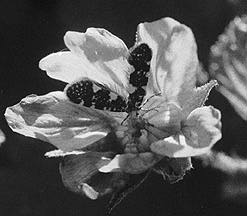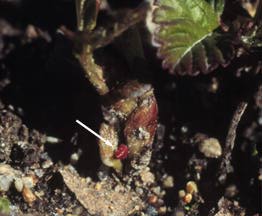Lampronia corticella
Lampronia rubiella , Raspberry bud moth
Olle PellmyrAdult Characteristics
Depicted in Heath & Pelham-Clinton (1976). Wingspan 9-12 mm. Head light ochreous. Forewing groundcolor fuscous, with slight purplish tinge; 4-5 creamy spots on costa and 2 on hind margin, with many small spots on veins in distal two thirds of the wing. Hindwings gray.
Host, Oviposition, and Larval Feeding Habits
Described in detail by Hill (1952) and Hellqvist (1990); ovipositing female and late-instar larva depicted in the latter. Egg is laid in the wedge between the stamens and petals in flowers of Rubus idaea (raspberry), R. arcticus, R. saxatilis and probably other species of Rubus. Larvae feed inside the fruit (seeds and/or receptacle) for two instars, then overwinter in a round, dark cocoon in shallow soil near the plant root. Larvae enter young buds and adjacent pith in the spring. Larvae pupate on a leaf surface or inside the gallery. The adult emerges in early summer.
Geographic Distribution
Widely distributed from the British Isles, through continental Europe and Fennoscandia, east across Russia to Sakhalin, and south to Altai. The species has been introduced in North America, and was first found in New Brunswick, Canada, in 1936.
Habitat
In habitats with Rubus species, including orchards where spring feeding can have a significant impact on fruit production.
References
Heath, J. & E.C. Pelham-Clinton. 1976. The moths and butterflies of Great Britain and Ireland, vol I: Incurvariidae. Blackwell Scientific Press and Curwen Press.
Hellqvist, S. 1990. Hallonmal, Lampronia rubiella (Bjerk.), som skadedjur på allåkerbär. Växtskyddsnotiser 54:107-112.
Hill, A.R. 1952. The bionomic of Lampronia rubiella (Bjerk.), the raspberry moth, in Scotland. J. Horticult. Sci. 27:1-13.
About This Page

University of Idaho, Moscow, Idaho, USA
Page copyright © 1996
 Page: Tree of Life
Lampronia corticella . Lampronia rubiella , Raspberry bud moth.
Authored by
Olle Pellmyr.
The TEXT of this page is licensed under the
Creative Commons Attribution-NonCommercial License - Version 3.0. Note that images and other media
featured on this page are each governed by their own license, and they may or may not be available
for reuse. Click on an image or a media link to access the media data window, which provides the
relevant licensing information. For the general terms and conditions of ToL material reuse and
redistribution, please see the Tree of Life Copyright
Policies.
Page: Tree of Life
Lampronia corticella . Lampronia rubiella , Raspberry bud moth.
Authored by
Olle Pellmyr.
The TEXT of this page is licensed under the
Creative Commons Attribution-NonCommercial License - Version 3.0. Note that images and other media
featured on this page are each governed by their own license, and they may or may not be available
for reuse. Click on an image or a media link to access the media data window, which provides the
relevant licensing information. For the general terms and conditions of ToL material reuse and
redistribution, please see the Tree of Life Copyright
Policies.
Citing this page:
Pellmyr, Olle. 1996. Lampronia corticella . Lampronia rubiella , Raspberry bud moth. Version 01 January 1996 (under construction). http://tolweb.org/Lampronia_corticella/12358/1996.01.01 in The Tree of Life Web Project, http://tolweb.org/









 Go to quick links
Go to quick search
Go to navigation for this section of the ToL site
Go to detailed links for the ToL site
Go to quick links
Go to quick search
Go to navigation for this section of the ToL site
Go to detailed links for the ToL site